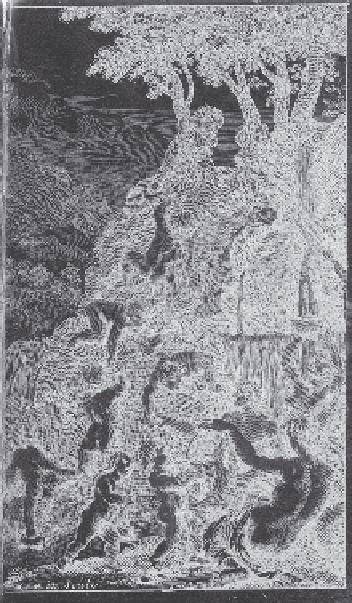Geoscience Reference
In-Depth Information
Fig. 14.5 Symbolic representation of the origin of
springs in Perrault's (1674) topic, showing
how nymphs carry water from the river to
the mountain top where it can start to flow
as a spring. (Courtesy Mandeville
Collections Library, University of
California, San Diego.)
on the mountains and hills, flow down from the slopes and end up in the rivers and in the
creeks; under these rivers and the plains, which they drain, there are layers of clay and other
impermeable material; therefore the river waters enter into the more permeable top layers
of the plains, mostly laterally, often also by overflowing and flooding. Inside the Earth the
water vaporizes by various mechanisms, namely by heat, by cold and by the movement of
the air particles, whereupon this vapor rises inside the Earth to the summits of the mountains,
where it condenses again to make springs. In support of this explanation, he also invokes the
authority of several of the authors of his literature review, among whom Aristotle, Seneca,
and Descartes, who had proposed similar mechanisms. His overall conclusion is that, while
both springs and rivers are caused by precipitation, in the case of the springs the relationship
is indirect, because the water must first enter into the rivers before it can produce springs.
Hence springs are not the cause of rivers, but rivers are the cause of springs, so that if there
were no rivers there would also be no springs. This imagined transport from rivers to springs
was illustrated allegorically in Perrault's topic, as reproduced in Figure 14.5.
Considering the state of measurement technology and of open channel hydraulics,
Perrault's comparison between river runoff and precipitation was a remarkable feat. So,
not surprisingly, in most reviews of the history of hydrology Perrault's work, with its
emphasis on experimentation, is rightfully acclaimed as one of the significant landmarks
of this science. On the other hand, however, it is usually overlooked, or not fully realized,
that in fact one of the main objectives of Perrault's (1674) topic, was to refute the largely
correct Common Opinion. Thus in this sense, a large part of his work was also a major step
backward. Perrault arrived at his erroneous notion mainly on the basis of a sand column

